

Windows 8 and the App Ecosystem. It has been a long time coming, but Microsoft’s omnipresent operating system is getting a major lick of paint for the launch of Windows 8 on October 26.

The Redmond-based computing giant’s new offering has already been available in various pre-launch guises, however, with the Developer Preview version rolling out in September last year, followed by the Consumer Preview (February 2012), and Release Preview (May 2012). Then, on August 1, Windows 8 was released to manufacturing (RTM), with all the major creases ironed out. In theory, at least. But with such a gradual path to launch, opinions have already been formed in many circles – it’s fair to say that the consensus has been rather lukewarm, with perhaps a slight leaning towards negative. What Microsoft is attempting to do is rethink Windows for the 21st century, touchscreen generation, reeling in big changes to the interface and navigation. Meet Anand Krishnan. Microsoft Says It Has Sold 40 Million Windows 8 Licenses.
One month since the Windows 8 launch event (above) Microsoft says it has sold 40 million Windows 8 licenses.
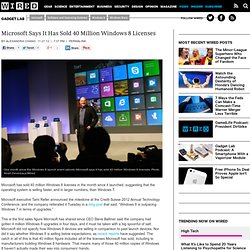
Photo: Noah Devereaux/Wired. 'Demand For Windows 8 Is Not That Good Right Now,' Says Asus CFO.
Betting the Company on Windows 8. I'd argue that the last truly revolutionary version of Windows was Windows 95.

In the subsequent 17 years, we've seen a stream of mostly minor and often inconsequential design changes in Windows – at its core, you've got the same old stuff: a start menu, a desktop with icons, taskbar at the bottom, overlapping windows, toolbars, and pull-down menus. Windows 7 may be bigger, prettier, and more refined – finally, a proper sequel to Windows XP – but it's also safe. Rote. Familiar. Maybe a little too safe. Windows 95 was a big deal because it innovated, because it was a break from the status quo. But we all know how that story ends – with the iPhone in 2007, and most of all the iPad in 2010, Apple popularized the idea of simple touch computing surfaces that are now defining the Post-PC Era.
Windows 8 launching late October, RTM 'on track' for August. Microsoft's Tami Reller has announced that Windows 8 will Release to Manufacturing (RTM) in the first week on August, with a release in late October to retail stores.

Speaking at the company's Worldwide Partner Conference in Canada, Reller revealed that the company is "on track" to finishing the final copy of Windows 8 in early August. General availability, when the software and devices are available in stores, is expected in late October according to Reller. Microsoft revealed in late May that an RTM announcement was due "within two months," and an early August date appears to be in line with the company's initial expectations. Microsoft has been compiling final versions of the operating system recently, which include new features and the removal of Microsoft's Aero Glass UI in desktop mode.
Final thoughts on Windows 8: A design disaster. A week ago, Microsoft delivered the Windows 8 Release Preview, the final pre-release of the platform before the forthcoming operating system hits the release-to-manufacturing stage.
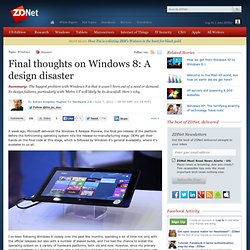
OEMs get their hands on the final code at this stage, which is followed by Windows 8's general availability, where it's available to us all. I've been following Windows 8 closely over the past few months, spending a lot of time not only with the official releases but also with a number of leaked builds, and I've had the chance to install the operating system on a variety of hardware platforms, both old and new. However, since my primary working platform is a desktop system, this is where I've had the chance to spend the most time with Microsoft's new operating system. I'm now ready to sum up my Windows 8 experience with a single word: awful. I could have chosen a number of other words -- terrible, horrible, painful and execrable all spring to mind -- but it doesn't matter, the sentiment is the same.
Related: Steve Ballmer DIDN'T Predict A Half A Billion Windows 8 Users In 2013. So Steve Ballmer isn't going around saying that half a billion people will be using Windows 8 in 2013, as was reported by the AFP and commented on by us.
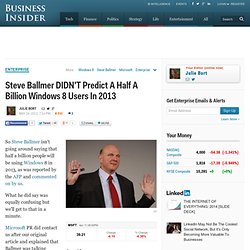
What he did say was equally confusing but we'll get to that in a minute. Microsoft PR did contact us after our original article and explained that Ballmer was talking about the number of Window 7 machines that COULD upgrade to Windows 8, not the number of people that WOULD actually use Windows 8 in its first year. We asked them to send us Ballmer's exact quote. They didn't, but Todd Bishop at GeekWire got a hold of the transcript and published the remark: "With something like 400 million to 500 million users expected in the next year, the best economic activity for people building machines, and the best economic opportunity for people writing applications will be around Windows," Ballmer said, according to Bishop.
Best economic activity for writing applications? CONFIRMED: Microsoft Will Charge $15 For Windows 8 Upgrade. Try Chrome in Metro mode. Windows 8 Store: A good start, but can it top Apple’s App stores? When Windows 8 ships this fall, it will represent both the next iteration of Windows on the desktop and Microsoft's answer to Apple's dominance of the tablet market.
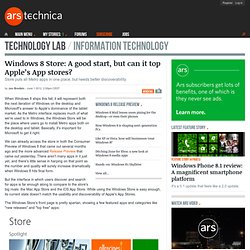
As the Metro interface replaces much of what we're used to in Windows, the Windows Store will be the place where users go to install Metro apps both on the desktop and tablet. Basically, it's important for Microsoft to get it right. We can already access the store in both the Consumer Preview of Windows 8 that came out several months ago and the more advanced Release Preview that came out yesterday. There aren't many apps in it just yet, and there's little sense in harping on that point as the number and quality will surely increase dramatically when Windows 8 hits final form.
But the interface in which users discover and search for apps is far enough along to compare to the store's big rivals: the Mac App Store and the iOS App Store. Updating and uninstalling Uninstalling Metro apps is also simple. Microsoft Recruits Designers in Race for Windows Apps. Microsoft Corp.
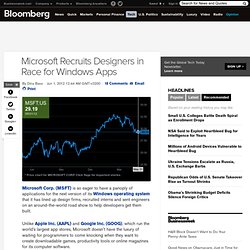
(MSFT) is so eager to have a panoply of applications for the next version of its Windows operating system that it has lined up design firms, recruited interns and sent engineers on an around-the-world road show to help developers get them built. Unlike Apple Inc. (AAPL) and Google Inc. (GOOG), which run the world’s largest app stores, Microsoft doesn’t have the luxury of waiting for programmers to come knocking when they want to create downloadable games, productivity tools or online magazines for its computer software. As Microsoft struggles to keep up with a technology landscape that is moving beyond personal computers into a future defined by mobile devices, the company is under pressure to gain a toehold in tablets. Windows 8 Release Preview: new apps, improvements, and Flash support (hands-on) Two months after giving people a first taste of Windows 8 with the Consumer Preview, Microsoft's back with the latest step toward the release of the company's next operating system: the Windows 8 Release Preview.
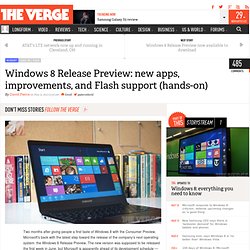
The new version was supposed to be released the first week in June, but Microsoft is apparently ahead of its development schedule — though that hasn't stopped the leaks from coming fast and furious. The Release Preview isn't nearly the upgrade the Consumer Preview was, but it's a clear move toward a stable, feature-complete operating system.
We got to spend some time with the Release Preview on a Samsung Series 9 laptop, checking out the new features and trying to figure out whether Windows 8 will be equally well suited to touch and non-touch devices. The basic look and feel of Windows 8 hasn't changed — even Aero is still present, though it'll be gone before RTM — but performance has definitely been improved. New Features Flash has been crippled on purpose Apps Wrap-up Previous. Fear and Loathing and Windows 8. (Or: Why Windows 8 Scares Me -- and Should Scare You Too) I was very excited when I saw the first demos of Windows 8.
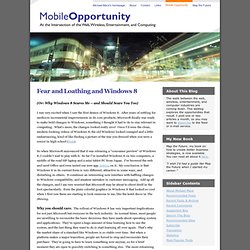
After years of settling for mediocre incremental improvements in its core products, Microsoft finally was ready to make bold changes to Windows, something I thought it had to do to stay relevant in computing. No-cost desktop software development is dead on Windows 8. Microsoft wants Windows developers to write Windows 8-specific, Metro-style, touch-friendly applications, and to make sure that they crank these apps out, the company has decided that Visual Studio 11 Express, the free-to-use version of its integrated development environment, can produce nothing else.
If you want to develop desktop applications—anything that runs at the command line or on the conventional Windows desktop that remains a fully supported, integral, essential part of Windows 8—you'll have two options: stick with the current Visual C++ 2010 Express and Visual C# 2010 Express products, or pay about $400-500 for Visual Studio 11 Professional. A second version, Visual Studio 11 Express for Web, will be able to produce HTML and JavaScript websites, and nothing more. Visual Studio 11 is an improvement in many ways over Visual Studio 2010. Its C++ compiler, for example, is a great deal more standards-compliant, especially with the new C++ 11 specification. It gets worse. Microsoft clarifies Ballmer's claims of massive Windows 8 adoption. Computerworld - Reports earlier this week that Microsoft CEO Steve Ballmer predicted unprecedented sales of Windows 8 were wrong on multiple counts, Microsoft and independent analysts agreed.
But while Microsoft said Ballmer was misquoted or misunderstood, the analysts argued that even if the CEO's number of 500 million had been accurate, it meant little about the upgrade's success. The kerfuffle started when the Agence France-Presse (AFP) wire service, reporting from a South Korean technology event, said Ballmer claimed up to 500 million users would "have" Windows 8 "next year. " A slew of blogs and news websites piled on, most of them questioning Ballmer's number, or even his sanity. It wasn't hard to see why: Windows 7, which Microsoft has repeatedly said has been the fastest-selling operating system in its 37-year history, sold roughly 525 million licenses between its 2009 launch and the end of 2011.
Very skeptical. Up to 500 million Windows 8 users by end of 2013, says Ballmer. Earlier today, we reported that Microsoft CEO Steve Ballmer said that 350 million devices with Windows 7 would be sold in 2012. Now a new report from AFP claims that Ballmer has made yet another prediction, this time on the sales of Windows 8. In a speech to the Seoul Digital Forum in South Korea today, Ballmer said that up to 500 million users will be using a Windows 8 device by the end of 2013.
Microsoft is expected to launch Windows 8 officially sometime before the end of 2012. Ballmer added, "It's really, in some senses, a dawning of the rebirth of MS Windows... It's certainly the most important piece of work we've done. " Ballmer also said that Microsoft will "soon" launch a version of Skype for Windows 8. Ballmer also spoke about the cloud computing industry today, predicting that in a few years there will only be a few companies that will dominate that industry.
Image via Microsoft.